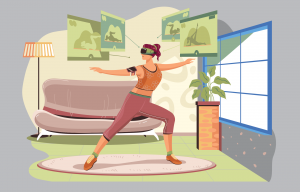What has long been a trend in the game industry is now gaining ground in medicine. The Use of Virtual Reality in Psychiatry promises completely new possibilities in various disease treatments. The value of the VR healthcare industry also grows steadily: by 2025 it`s expected to grow to $4.64 billion.
Psychotherapists treat patients who are afraid to fly airplanes. Patients swim with sharks while lying in a hospital bed. Medical students anatomize human bodies at a virtual table. What sounds like the future is already being tested in research and may soon become part of everyday life in clinics and practices. This is made possible by VR technologies. The potential it offers is enormous and the number of applications is varied.
What is virtual reality? Can it help cure a mental disease? And if so, then how?
What Is VR?
Virtual Reality is a computer-generated reality. To immerse in this virtual world, special devices are required. The higher the quality of the devices, the more intense the experience or a sense of immersion.
The key component of the virtual world is VR glasses and applications that are usually developed based on the needs of the company, its goals, and the business model.
Inside the glasses, images are displayed on two high-resolution displays that transport the user into an artificial world with a 360-degree view. Other devices, such as gloves also allow various interactions. With the help of these gloves, you can not only experience virtual reality but also control it.
Various applications open up new possibilities for VR training. They are already used for the training of surgeons in medical schools, dental training, and mental health treatment.
How VR Works in Mental Health Treatment?
Let`s get the idea of what is real and what is virtual?
Although it may seem like an easy question, the answer to this question is not.
About 60% of our brain processes visual stimuli. This means that everything we see with our eyes (whether we like it or not) has a huge impact on us. Think of a horror movie: it involuntarily evokes strong emotions in you, even if the characters and actions are fictional. Of course, we know that the spider crawling across the virtual table is not real. But the visual stimulus is so strong that people suffering from spider phobia have sweat on their foreheads and heart palpitations.
Understanding the profound influence of visual stimuli, especially considering that about 60% of our brain processes such information, underscores the importance of knowing the early signs that trigger strong emotional responses. For instance, in a horror movie scenario, even though the characters and actions are fictional, the visual impact can evoke involuntary reactions, a phenomenon crucial to recognize for individuals dealing with specific phobias.
Our brains make no distinction between real and virtual. The real symptoms of anxiety occur as a physical reaction. This fact can be used in exposure therapy.
Until that day, classical exposure therapy (treatment of anxiety and fear by exposure to the anxiety source) has been the most effective treatment for phobias and fears. It shows positive results and is more resistant than psychotropic medications.
But in therapeutic practice, unfortunately, there are also many difficulties with it. Where do you get a tarantula for arachnophobia treatment? Should you buy an expensive ticket to overcome the fear of flying? How do you treat those who have a fear of heights?
Thus, exposure therapy can be logistically difficult, financially unaffordable, or unreasonable in terms of intensity depending on the anxiety disorder.
The virtual exposure therapy method prevents these difficulties by creating a bridge between safe practice and real daily life. With a virtual environment, therapists can precisely dose the frightening stimuli. This allows them to adjust the stimulus step by step according to your progress, making the fear predictable and controllable.
In this way, an optimal course of treatment is obtained. Medical institutions also save time and money, because they do not need to take extra hours. This also applies to patients who would otherwise find it difficult to manage their specific fears with exposure therapy, for example, in the case of emetophobia (fear of vomiting).
Therefore, we can point out four great benefits of virtual exposure therapy:
- Safety and control
- Costs benefits
- Time savings
- Applicability
In addition, working with virtual reality is just fun, and it motivates both the patient and the therapist. Psychological and mental treatment does not have to be boring. Look at your fear with different eyes! VR is a great addition to applied clinical psychology and rethinking best practices.
Avid Applications of VR in Medicine
1. Virtual Surgeries
Although virtual reality has been researched and tested for years, it is only gradually coming to other areas outside of the gaming industry. In-flight pilot training or post-traumatic disorder treatment, for example, their use has long been the standard; VR in the healthcare industry is only starting to make inroads.
At Heidelberg University Hospital, students recently practiced surgical operations in virtual reality while being at home.
Doctors are teaching new treatments to virtual patients and preparing for surgeries ranging from dental surgery to organ transplants. Virtual reality makes it possible to simulate every conceivable medical intervention. In this way, students and doctors can gain practical experience without any risks.
Such simulation allows learning faster and more effectively than by observing in a real operating room.
2. Treat Illnesses and Relieve Pain With Virtual Reality
Virtual reality has also shown great results in treating addiction, depression, and chronic pain. With the help of it, addicts learn to cope with situations that cause cravings for the drug.
For example, alcoholics are sent to a virtual pub where they practice refusing the drinks offered by the avatar. Nicotine addicts learn to wait at bus stops or drink coffee without having a cigarette.
This approach has been recently used by a team of researchers from University College London.
They also showed a myriad of other cases where VR can be used. For instance, to reduce self-critical behavior and thus alleviate depression the team developed a program where patients worked with their virtual image in the form of an avatar.
Such VR systems allow recording distortions in the perception of body images. In the virtual space, patients can change their perception of body image in front of a mirror and “recreate” other people’s body images. Discrepancies in self-perception can indicate distortions in the perception of body images.
The effect of virtual therapy on pain reduction is also relatively well documented. The University of Washington developed an artificial snowy landscape where patients with burn wounds are sent. During the painful procedures of changing bandages, patients walk through snowy landscapes, watch penguins, and can throw snowballs. This reduces pain by up to 50% – similar to administering a single dose of morphine. The basic idea is to engage the patient in another reality and thus reduce pain or stress through distraction.
A recent study at Cedars-Sinai Hospital in Los Angeles confirms the effectiveness of this method. Immersion into virtual worlds not only relieves pain but also prevents depression in long-term patients. For the study, doctors sent patients to fascinating underwater worlds where they could dive with dolphins and whales fly over impressive mountains, or travel to different lands.
3. Treating Anxiety Disorders at Home?
Digital therapies for the treatment of anxiety disorders at home are also gaining popularity. With the help of virtual reality glasses and an app, it will be possible to treat mental diseases at home.
The therapy program includes eight hours of therapeutic educational materials and nearly four hours of virtual reality images. The health insurance company says the app is suitable for treating agoraphobia, as well as for treating panic disorder and social phobias.
However, the German Association of Psychotherapists is critical of the use of health apps.
Federal Chairman Gebhard Henschel demands that the same evidence of effectiveness be applied to health apps as to traditional therapies. He is also of the opinion that health insurance companies should not prescribe VR therapies without a medical examination.
A health insurance company should not administer therapies without authorization, the effects and side effects of which are not evaluated and addressed.
Other experts, such as medical psychologist Bartosz Zurowski from the University Hospital of Lübeck, are convinced of the benefits of virtual reality:
“The time has finally come to start using these new digital technologies in outpatient care. I am convinced that this will significantly improve treatment and complement the existing spectrum of outpatient psychotherapy.”
4. VR and Chronic Stroke Treatment
There is also a great potential for faster and more successful therapy for chronic stroke, which can be implemented independently using VR. The perception of the movement of the paralyzed body part in the virtual world can contribute to the healing process.
A new study shows that the state of the brain during stimulation is crucial to whether plastic change occurs in brain networks. Successful therapy requires a control system tailored to the individual patient: every stroke is unique, and the optimal therapy must be tailored to the specific brain disorder. Intensive research in this field made virtual reality therapeutically effective.
5. Improved Coordination for People With Glaucoma
Glaucoma with chronic eye disease is fraught with the risk of loss of balance, falls, and injuries for the patient. According to the American Academy of Ophthalmology study, VR improved coordination in participants with glaucoma by 30 to 40 percent compared with healthy participants.
6. Virtual Heart
Stanford Lucile Packard Hospital cardiologist David Axelrod has developed a VR model of the heart to visualize congenital defects. The development has two practical uses:
– A teaching aid for students
– A visual demonstration for patients.
The heart is a complex three-dimensional organ, and it still has functions and diseases scientists do not fully understand. Ask any doctor and explain how difficult it is to describe what processes are inside this organ. Without a clear understanding of the course of the surgery, patients may experience unnecessary stress.
7. VR as a Weapon Against Cancer
Several VR companies are successfully helping patients with cancer. For example, numerous medical institutions have developed VR applications that relieve the stress of patients undergoing chemotherapy. During the procedure, they put on VR goggles on a patient and offer a boat trip on the harbor, to explore the seabed, and interact with koalas in the zoo.
The Future of Virtual Reality in Medicine

Despite numerous successful research results, VR therapy is still very rarely used in medical practice. One reason is that the technology has not yet been fully developed. Heavy helmets, sluggish sensors, and poor screens caused nausea and dizziness in many test subjects and prevented immersion.
However, recent research and developments in the VR market solved these technical problems. Various software development companies with sole expertise in VR development offer VR goggles and programs that are steadily improving. In this respect, 2021 could be the year when virtual reality makes a medical breakthrough.












